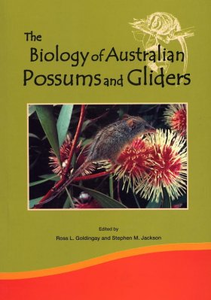Diet selection in marsupial folivores of Eucalyptus: the role of plant secondary metabolites
Foley, W.J., Lawler, I.R., Moore, B.D., Marsh, K.J., and Wallis, I.R. (2004) Diet selection in marsupial folivores of Eucalyptus: the role of plant secondary metabolites. In: Goldingay, Ross L., and Jackson, Stephen M., (eds.) The Biology of Australian Possums and Gliders. Surrey Beatty & Sons, Chipping Norton, NSW, Australia, pp. 207-221.
|
PDF (Published Version)
- Published Version
Restricted to Repository staff only |
||
![[img]](https://researchonline.jcu.edu.au/334/2.hassmallThumbnailVersion/1680_Winter_et_al_2004.jpg)
|
Image (JPEG) (Cover Image)
- Cover Image
Download (24kB) |
Abstract
Past efforts to explain feeding by eucalypt folivores focussed on three groups of plant secondary metabolites – phenolics, tannins and terpenes. It is yet unkownn if these compounds consistently limit the food available to marsupial folivores or whether they provide a better explanation of food choice or habitat quality than do nutrient concentrations alone. Recently, the formylated phloroglucinolc compounds were shown to defend many eucalypts against the marsupial browsers. This discovery has enhanced our understanding of the interaction between marsupial folivores and Eucalyptus while elaborating its complexity. Some informal subgenera of Eucalyptus, such as Monocalyptus, appear to lack formylated phloroglucinol compounds while others (e.g. Symphyomyrtus) contain a wide variety. Of most importance ecologically, is the huge variation in formylated phloroglucinol compounds between individual trees within species, even within a small area. This makes it impossible to generalize about “food trees” across species. The concentrations of formylated phloroglucinol compounds and terpenes in foliage are positively correlated. It appears that folivores use smell to gauge terpene concentrations and hence that of formylated phloroglucinol compounds, and thus avoid the foliage of some trees and feed from others. Thereafter, a physiological feedback mechanism, involving the emetic system, keeps the dose of formylated phloroglucinol compounds below a threshold. This understanding of formylated phloroglucinol compounds makes it pertinent to re-evaluate the roles of other plant secondary metabolites, particularly tannins, in marsupial feeding. However, the greatest challenge ahead is to extrapolate the results of feeding experiments with captive animals to predicaments of wild marsupial folivores. Near infrared spectroscopy provides a way of measuring formylated phloroglucinol compounds concentrations in samples from hundreds of trees. Preliminary research suggests that it may be possible to measure formylated phloroglucinol compounds at the landscape scale with remote sensing.
| Item ID: | 334 |
|---|---|
| Item Type: | Book Chapter (Research - B1) |
| ISBN: | 978-0-949324-96-2 |
| Keywords: | marsupial folivores, Eucalyptus, metabolites |
| Date Deposited: | 10 Nov 2006 |
| FoR Codes: | 06 BIOLOGICAL SCIENCES > 0602 Ecology > 060208 Terrestrial Ecology @ 80% 05 ENVIRONMENTAL SCIENCES > 0502 Environmental Science and Management > 050202 Conservation and Biodiversity @ 20% |
| SEO Codes: | 96 ENVIRONMENT > 9605 Ecosystem Assessment and Management > 960506 Ecosystem Assessment and Management of Fresh, Ground and Surface Water Environments @ 100% |
| Downloads: |
Total: 311 |
| More Statistics |



